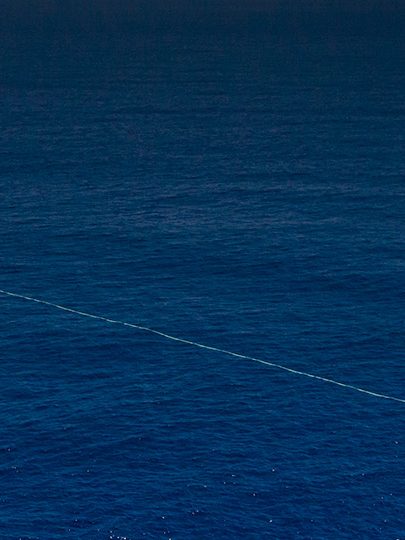

Macquarie 50th Anniversary Award
The Ocean Cleanup is an international non-profit project with the mission of ridding the oceans of plastic by expanding and scaling up its trash-capturing solutions in both oceans and rivers. |
of floating ocean plastic removed from the Great Pacific Garbage Patch over 23 trips1
of trash removed from ocean feeding rivers in eight countries across 21 deployments1
a scalable and operational ocean cleanup system1
The Ocean Cleanup is dedicated to advancing and expanding its innovative cleanup system to remove plastic from the Great Pacific Garbage Patch (GPGP). With support from the Macquarie 50th Anniversary Award, The Ocean Cleanup has successfully iterated and deployed a scalable, operational system. As of late 2024, their systems have completed 23 trips to the GPGP, removing over 500,600 kilograms of floating ocean plastic.1
To prevent plastic emissions from entering oceans via rivers, The Ocean Cleanup has also developed and deployed a system of Interceptors™ in several of the world’s most heavily polluted rivers. These Interceptors™ capture and extract floating riverine plastic before it can reach the ocean. The Ocean Cleanup has identified that the 1,000 most polluting rivers are responsible for 80 per cent of global plastic emissions, and they aim to implement Interceptors™ as a solution for all of them. Since 2019, 21 Interceptors™ have been launched in 8 countries, removing a total of 20 million kilograms of rubbish.1
To ensure long-term organisational sustainability and growth, a portion of the Macquarie 50th Anniversary Award funding was allocated toward expanding The Ocean Cleanup’s partnership and funding team, which now comprises 12 people. Since 2019, the organisation has secured $A300 million in funding to support the organisation’s future goals and initiatives.1
The grant has contributed greatly to our Rivers and Oceans program in general, and further, we have been able to build up a larger funding and partnership team, helping us attract additional funders to further our work.”
Nisha Bakker
Director of Fundraising
The Ocean Cleanup
A highlight for me has been leveraging my professional skills in a new context. I had the opportunity to work directly with The Ocean Cleanup’s finance team to provide insights into budgets and financial metrics. I was thrilled to be able to draw upon what I have learned at Macquarie to support the development of an organisation whose mission resonates with me personally.”
Alex Helliwell
Digital Solutions Owner for Sustainability
Macquarie Asset Management, London
In this video, hear from Dan van der Kooy, Senior Video Producer for The Ocean Cleanup as he captures the largest ocean clean up currently taking place around the world, and explains how the Interceptors™, a 100% solar-powered autonomous machine, is helping.
The Ocean Cleanup's System 03 brought a record haul of plastic to shore, returning back to the Great Pacific Garbage Patch for another season starting in February 2024. Since 2019, a total of 389,350 kilograms of plastic has now been removed from the Patch.
In March 2024, Interceptor 019 in Bangkok became the latest addition to the Rivers portfolio (technology solutions that intercept plastics in rivers before it reaches the ocean), while the very first Interceptor in Indonesia celebrated its five-year anniversary. To date, Interceptors have removed over 12 million kilograms of trash, working with local communities and stakeholders to prevent this rubbish from reaching the Ocean.
In early 2023, a new fundraising platform was launched, making it easier than ever for people to get involved and support the Ocean Cleanup to help rid the oceans of plastic.
In FY2023, The Ocean Cleanup conducted eight trips into the GPGP, removing 153,000 kilos of plastic from the ocean. This year also started the phased scale up of ocean System 002 to System 03 – a larger system capable of collecting much greater volumes of plastic.4
New Interceptor deployments or trials were launched in Guatemala and Jamaica; across the seven countries where the Interceptors are in place (with more deployments scheduled for late 2023), which prevented more than 1,800 megatonnes of trash from reaching the ocean. The Ocean Cleanup also sold out their stock of The Ocean Cleanup Sunglasses – made with plastic extracted directly from the GPGP and raising sufficient funds to clean up over 500,000 football fields’ worth of ocean.1
In FY2022, the Ocean Cleanup made substantial progress in their mission to rid the world’s oceans and rivers of plastic, pioneering ground-breaking research, reaching proof of technology with their latest ocean system (System 002), and deploying new Interceptor solutions that prevent plastic from entering the ocean from rivers in Dominican Republic, Malaysia, Jamaica and Vietnam.1
In FY2021, the Ocean Cleanup successfully deployed Interceptor 004 to capture plastic in the Rio Ozama, Dominican Republic, stemming the flow of plastic before it reaches the Caribbean Sea.1